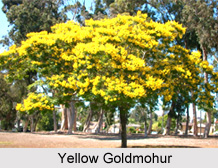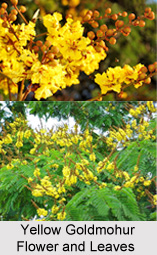 Yellow Goldmohur is a very handsome tree with its spreading crown of many branches consisting of feathery mimosa like leaves and abundance of bright yellow blooms. Thus the tree is much cultivated as an ornamental and is often planted alternately with Gulmohur. Although the plant is native to Sri Lanka and the Andaman Islands it is also found in the countries of India, Malaysia and northern parts of Australia and a popularly ornamental tree grown around the world. Hence it can be concluded that Yellow Goldmohur is grown more because of its ornamental beauty than its medicinal values. The Yellow Goldmohur is planted alternatively in contrast with the Gulmohur in Kolkata. In Kolkata it is known by the name "Radhachura" in contrast with the reddish "Krishnachura" or Gulmohur.
Yellow Goldmohur is a very handsome tree with its spreading crown of many branches consisting of feathery mimosa like leaves and abundance of bright yellow blooms. Thus the tree is much cultivated as an ornamental and is often planted alternately with Gulmohur. Although the plant is native to Sri Lanka and the Andaman Islands it is also found in the countries of India, Malaysia and northern parts of Australia and a popularly ornamental tree grown around the world. Hence it can be concluded that Yellow Goldmohur is grown more because of its ornamental beauty than its medicinal values. The Yellow Goldmohur is planted alternatively in contrast with the Gulmohur in Kolkata. In Kolkata it is known by the name "Radhachura" in contrast with the reddish "Krishnachura" or Gulmohur.
Different Names of Yellow Goldmohur
Generally known by the English name Yellow Goldmohur is also known as "Radhachura" in Bengali, "Peela Gulmohur" in Hindi, "Perunkonrai" in Tamil and "Kondachinta" in Telegu. The scientific name of this plant is "Peltophorum Pterocarpum" which belongs to the Gulmohur family. "Copperpod", "Golden Flamboyant", "Yellow Flamboyant", "Yellow Flame Tree", "Yellow Poinciana" are its common names.
Characteristic Features of Yellow Goldmohur
 Yellow Goldmohur can be called a handsome tree with dense leaves and a grey bark. It has dark green leaflets and fragrant yellow flowers. It is a medium sized deciduous tree growing to 15-25 m (rarely up to 50 m) tall, with a grayish rough bark. The crown has a typical umbrella shape. The leaves are bipinnate, 30-60 cm long, with 16-20 pinnae, each pinna with 20-40 oval leaflets 8-25 mm long and 4-10 mm broad. The tree bears bright yellow and fragrant flowers in bunches found on erect, terminal inflorescence of 30-43 cm long. Flowers are bisexual, with yellow petals that are tissue-thin and crinkled. The fruit is a pod 5-10 cm long and 2.5 cm broad, red at first, ripening black, and containing one to four seeds. Trees begin to flower after about four years. The tree is deciduous and sheds its leaves after a dry spell, usually around February and August each year.
Yellow Goldmohur can be called a handsome tree with dense leaves and a grey bark. It has dark green leaflets and fragrant yellow flowers. It is a medium sized deciduous tree growing to 15-25 m (rarely up to 50 m) tall, with a grayish rough bark. The crown has a typical umbrella shape. The leaves are bipinnate, 30-60 cm long, with 16-20 pinnae, each pinna with 20-40 oval leaflets 8-25 mm long and 4-10 mm broad. The tree bears bright yellow and fragrant flowers in bunches found on erect, terminal inflorescence of 30-43 cm long. Flowers are bisexual, with yellow petals that are tissue-thin and crinkled. The fruit is a pod 5-10 cm long and 2.5 cm broad, red at first, ripening black, and containing one to four seeds. Trees begin to flower after about four years. The tree is deciduous and sheds its leaves after a dry spell, usually around February and August each year.
Medicinal Values of Yellow Goldmohur
Although this was not a traditional medicinal plant of India yet it has profuse medicinal uses in Java. It is known to possess antibacterial and antifungal properties. The barks from which extracts are taken are believed to be effective in curing dysentery and relieving ulcers, muscular pain and sprains. The extracts can also be used as an eye lotion, gargle and even tooth powder.



















